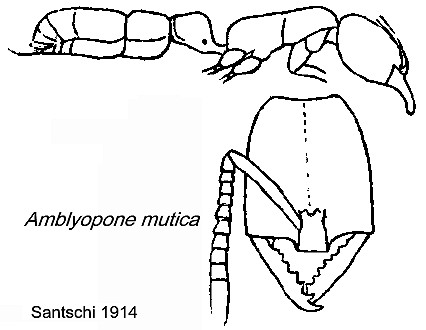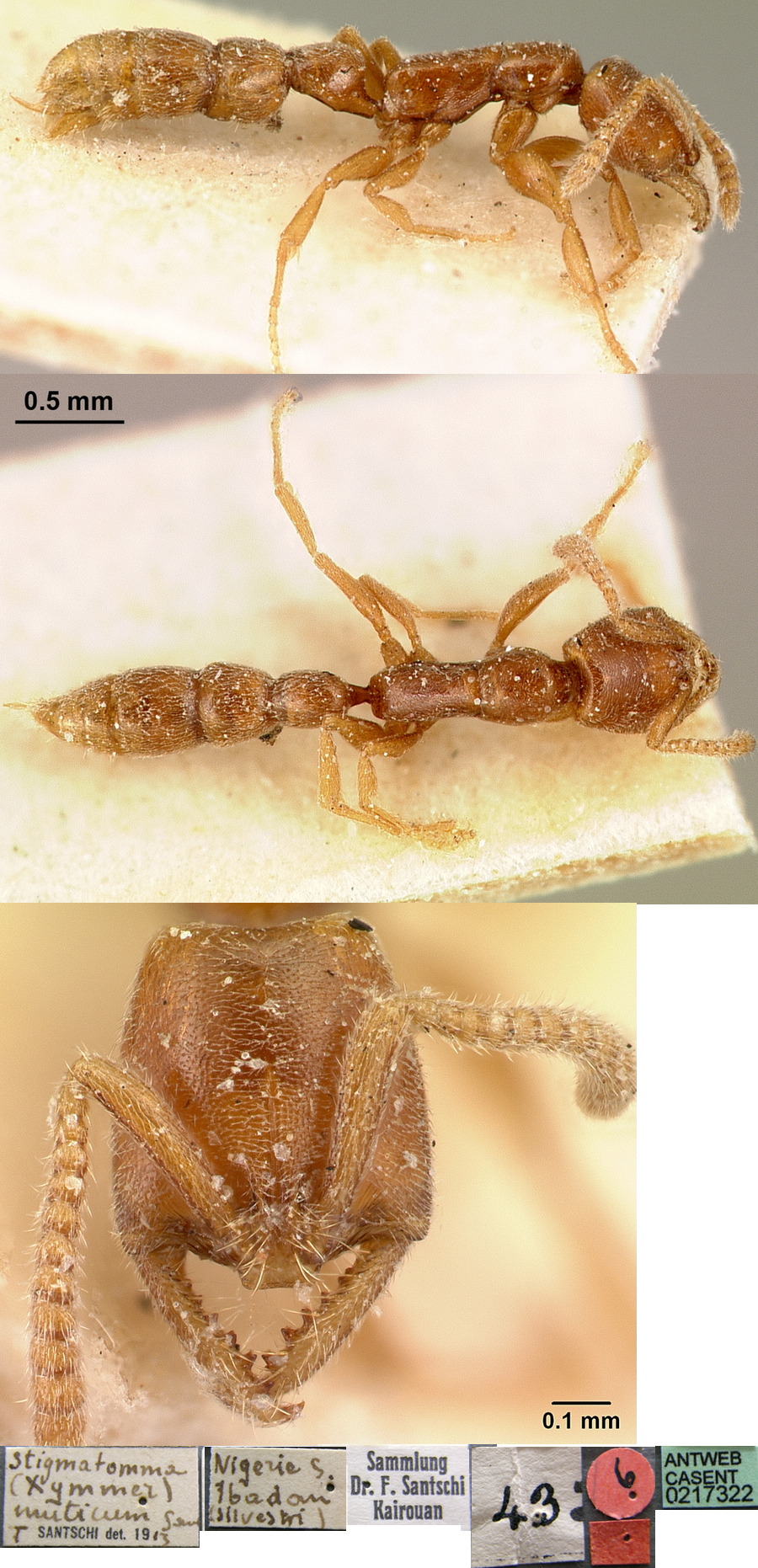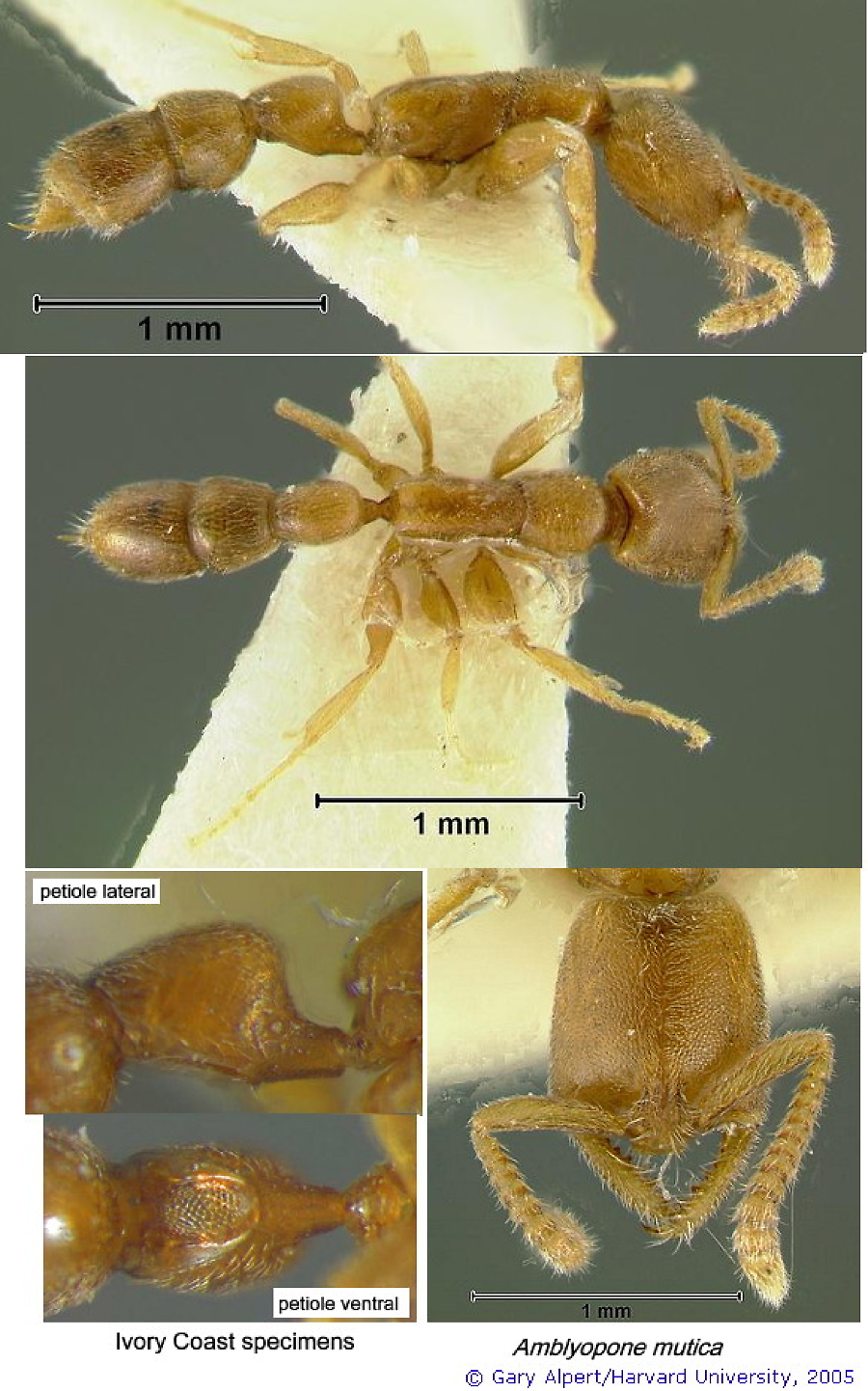Xymmer muticus (Santschi)
  Type location Nigeria (Stigmatomma
(Xymmer) muticum n. sp., Santschi, 1914d: 311, illustrated, worker;
in Wheeler (1922) as Xymmer muticum; status combination revived
by Yoshimura & Fisher, 2012)
from Ibadan, collector F. Silvestri, in 1913; worker only described
(see Bolton, 1995); Type location Nigeria (Stigmatomma
(Xymmer) muticum n. sp., Santschi, 1914d: 311, illustrated, worker;
in Wheeler (1922) as Xymmer muticum; status combination revived
by Yoshimura & Fisher, 2012)
from Ibadan, collector F. Silvestri, in 1913; worker only described
(see Bolton, 1995);  . .
TL 3.5 mm or less; clypeus devoid of teeth or tubercles,
petiole narrowed anteriorly to form a short peduncle (in Gotwald &
Lévieux, 1972).
This has changed with the paper by Yoshimura &
Fisher
(2012) who revived the monotypic Xymmer.
|
 Santschi's
description (1914d, my translation) is at Santschi's
description (1914d, my translation) is at  . .
WORKER - TL 3.5 mm, including mandibles. Colour brownish-red;
mandibles, antennae and legs more yellowish. Shiny; smooth with very
fine but quite dense puncturation. Hairs limited to a very few around
the mouth and gastral apex. Pubescence all over quite abundant but not
concealing the sculpturation.
Head a fifth longer than wide, a quarter more narrow behind than in
front; sides slightly arcuate, near straight and posterior border
distinctly concave. Blind, sometimes a rudimentary facet at the
posterior third. Frontal carinae set well apart; clypeus rectangular
four times wider than long. Frontal notch very narrow. Scape reaching
the posterior quarter of the head. All funiculus segments wider than
long. Mandibles shiny, densely punctate, narrow, length about
three-quarters that of the head; external border near straight in basal
four-fifths before the strongly convex apical fifth. Internal border
slightly convex and with eight teeth strong and simple (rarely
bifurcate) with the space between second and third bigger than between
others. Thorax dorsum flat and sub-bordered. Pronotum a quarter longer
than wide. Mesonotum and propodeum fused, about three times longer than
wide, with almost straight sides. Propodeum dorsum more distinctly
bordered behind, passing into the declivity with a sharp curve.
Declivity, straight from one side to the other, convex from above to
bottom in the lower third, concave basally. Petiole node a third longer
than wide, sides somewhat convex, higher in front than behind. Without
ventral process but with a very low simple tubercle. First segment of
gaster shorter than petiole, high than long and as long as the
posterior width.
This species is characterised by the clypeus having no armament and
being lobed.
Nigeria, Ibadan, 4 workers.
|
 The
photomontage of the holotype is collated from http://www.antweb.org/specimen.do?name=casent0217322. The
photomontage of the holotype is collated from http://www.antweb.org/specimen.do?name=casent0217322.
|
 Collected from leaf
litter, 3 workers from 2 sites (Bobiri
Forest Reserve, denuded primary forest; Nankasi, cocoa) in Ghana
(Belshaw & Bolton, 1994b). Collected from leaf
litter, 3 workers from 2 sites (Bobiri
Forest Reserve, denuded primary forest; Nankasi, cocoa) in Ghana
(Belshaw & Bolton, 1994b).
In Ivory Coast, named as one of 5 or 6 members
of the genus found at Lamto (Brown, Gotwald & Lévieux (1971).
Described as found both in humid savannah and forest by Gotwald &
Lévieux (1972).
Also listed in Hölldobler & Wilson (1990: 559). The
photomontage is collected from images at www.discoverlife.org
- originals by Gary Alpert, Harvard University; Ivory Coast specimens.
|
|